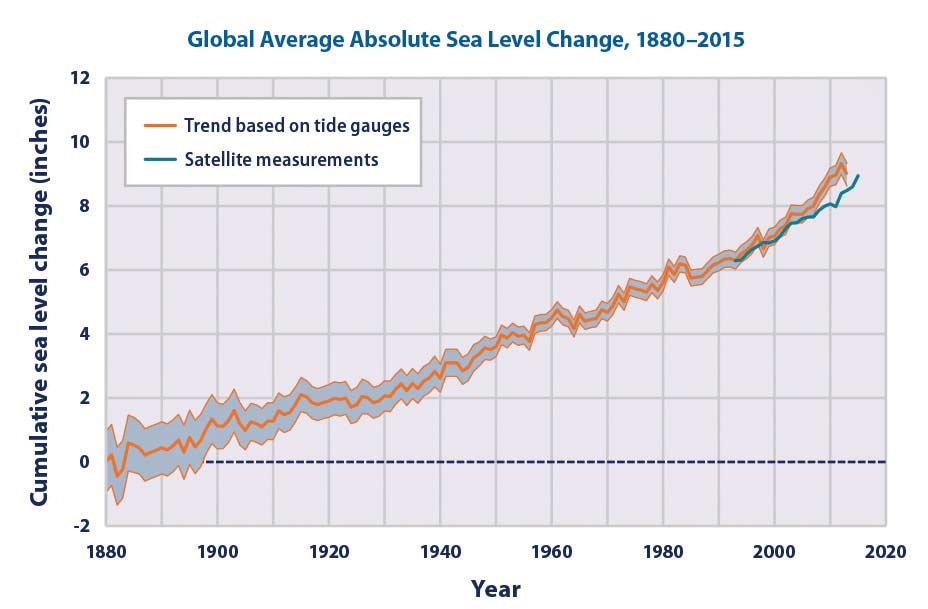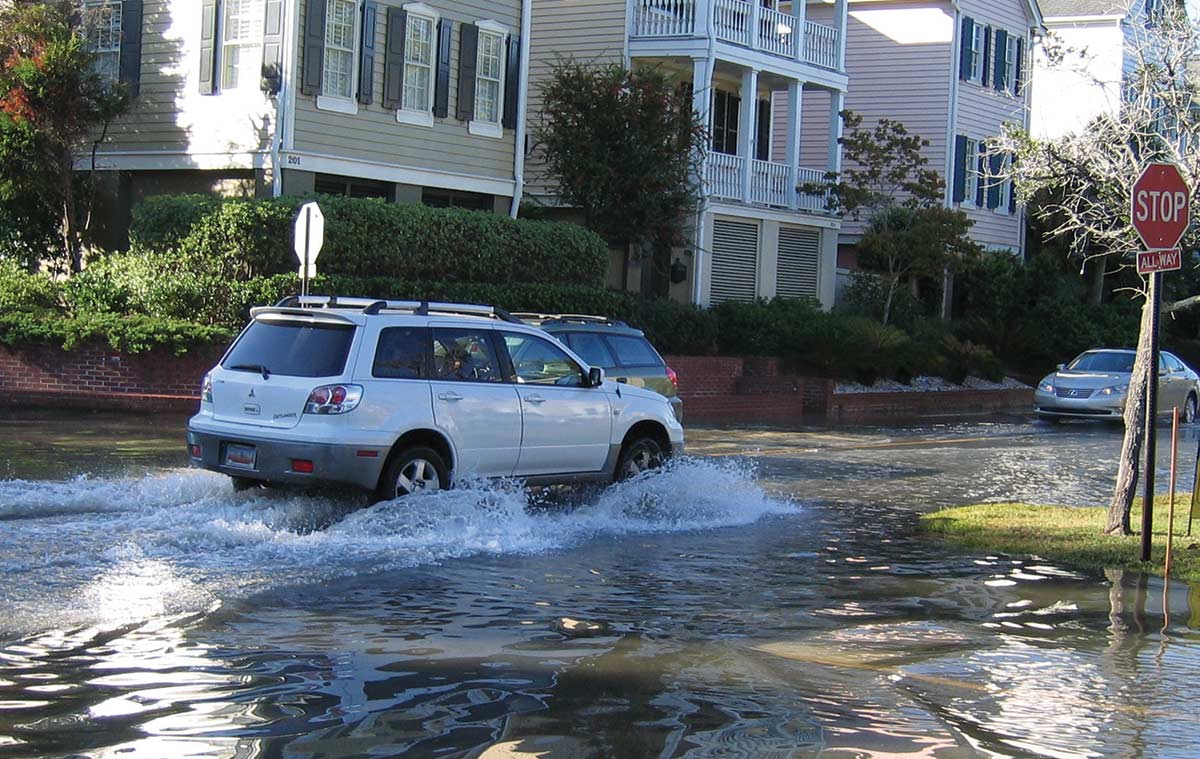[vc_row][vc_column][vc_column_text]
Sea levels are rising across the globe, leading to increased concern for the safety of coastal communities and wildlife populations.
Sea levels are rising as a direct result of the earth’s warming. Due to this warming, the permanent ice sheets over Greenland and Antarctica are melting, which means less sea ice (ice floating in the polar ocean areas) is being formed each winter. Further complicating the matter, the warmer the water the more it expands, which also takes up an increased amount of space. The melting and loss of sea ice has accelerated over the last decade and is now believed to be one of main causes of increasing sea levels. This is irrefutable evidence of global warming, which isn’t limited to one incident but marks a trend of increasing ocean temperatures and levels.

According to the National Atmospheric and Oceanic Agency’s (NOAA) State of the Climate Report (ncdc.noaa.gov/sotc), 2015 was the second warmest year on record for the U.S. The report stated that it was “the 19th consecutive year the annual average temperature exceeded the 20th century average”. Not only were global temperatures measured at the highest level ever recorded, but they also broke the previous temperature records by an unprecedented margin. And after the data points for 2016 temperatures are finalized, we may find that 2016 was even warmer than 2015. Overall, the earth has been warming since comprehensive temperature records have been kept in 1880, and this warming rate has increased in recent decades. Global warming has been attributed to the actions of humanity, particularly those that have increased the global quantities of greenhouse gases such as carbon dioxide. For example, prior to the Industrial Revolution in the 18th century, atmospheric carbon dioxide levels were about 280 ppm (parts per million). Today, that level rests at about 400 ppm.
Global warming is an issue for both the Northern and Southern Hemispheres. The Arctic region is facing the harshest increases in temperature. In 2006, NOAA started issuing an annual Arctic Report Card documenting observed weather conditions. The 2016 report is particularly disturbing. The average annual air temperature over land areas was the highest on record with a 6 degrees F increase since 1900, while the Arctic Ocean temperatures were 9 degrees F above average in August. Spring snow cover was at a record low in the North American Arctic, as was sea ice in the fall. On December 22, 2016, a weather buoy just 90 miles south of the North Pole registered a temperature of 32 degrees F, nearly 50 degrees above normal. Even more disturbing, one study suggests that the Greenland ice sheet lost one trillion tons of ice between 2011 and 2014 alone.
There are two ways to accurately measure sea level. Tide gauges have recorded local sea levels for more than a century. However, the old ruler-type gauges are giving way to modern microwave sensor stations. And in the past 20 years, satellite measurements have been available that use laser altimeters. According to NOAA, the sea level has been rising for the last 100 years (corresponding to an increase in the earth’s temperature), and the rate of rise has been increasing in recent decades. Globally, the overall rise in sea level is eight inches, which may not sound like much, so for reference consider that nearly 70 percent of the earth’s surface is covered by water—an estimated 3.5 x 1020 gallons. Also keep in mind that the surface of the ocean isn’t simply flat since the moon’s gravitation causes a significant bulge that moves with the earth’s rotation and causes the tides. Local currents and winds also distort sea level.
Why should we be worried about rising sea levels? About 40 percent of the U.S. population lives in coastal areas, all of which are at risk of flooding. According to NOAA, “Flooding increased on all three U.S. coasts between 300 and 925 percent since the 1960s, with the biggest increases in the Mid-Atlantic.” Naturally, we expect the damaging high tides and storm surges of hurricanes or other coastal storms, but the danger is intensified by higher sea levels, which allow these storm-induced tides to reach further inland and produce even more destruction.
One of the most pressing problems related to rising sea levels is the increased occurrence of “nuisance floods,” which are typically not storm related but rather occur with unusually high astronomical tides. Perigean spring tides or “king tides” occur several times a year when the moon is closest to the earth. Normally, the flooding caused by perigean spring tides is usually minor in low-lying areas and at their worst produce road closures and minor damage. However, in recent years, this tidal flooding has gotten progressively worse and is far beyond just being a nuisance. Roads are frequently becoming submerged under deeper water for increasingly longer periods of time. Homes and businesses have also experienced flooding in their basements. Some king tides rank with major storm tides as the highest on record. South Florida was hit particularly hard by these tides in the fall of 2016.
Wildlife is also severely impacted by rising seas and the resulting loss of coastal habitats. Warmer water temperatures have a negative impact on animal and fish populations that are already adapted to cooler water temperatures. Furthermore, algae blooms occur more frequently in warmer water temperatures, bringing about an increasing number of “red tides”.
What does the future hold? Scientists agree that sea levels will continue to rise as the earth’s temperature rises. Estimates predict that by 2100, sea levels will likely be at least a foot higher than they are today, but this is assuming we don’t have a rapid collapse of the major ice sheets, which could lead to water level rises of 20 to 30 feet.
Is there anything we can do as global citizens to mitigate the impact of global warming? Certainly, we need to cut greenhouse gas emissions around the world, but we also have to prepare for rising sea levels. The infrastructure of coastal cities and communities will need adaptations to prepare for rising sea levels, and ultimately some may need to be abandoned. But rising sea levels impact the entire planet and each of us should take steps to reduce our global footprint. For more information visit arctic.noaa.gov/report-card or climate.gov.
By Ed Brotak, Southern Boating
February 2017[/vc_column_text][/vc_column][/vc_row]













